From the July/August 2022 issue of Apollo. Preview and subscribe here.
Around 735 AD, the Christian missionary Boniface wrote to the scribe Eadburga, abbess of Wimborne in Dorset. He asked her to make a copy, in gold, of the Petrine Epistles, to ‘impress honour and reverence for the Sacred Scriptures visibly upon the carnally minded to whom I preach’. From the earliest period, gold has been an expression of power – sacral power, political power – and a symbol of beauty.
The British Library’s new ‘Gold’ exhibition contains 50 spectacular manuscripts and objects from around the world. Here gold appears in multiple forms: as a pigment ground up and used in ink, as strips used as writing surfaces, as flecks on Chinese paper and in the tooled grooves of leather bindings. Entering an exhibition presumably focused on books, you might not expect to find a case displaying two strips of pure gold measuring around 30 cm by 3 cm, on which are inscribed some of the oldest known textual fragments in Pali, written in Pyu script and dating to the 5th–6th centuries. The strips were made to be rolled up and placed at the base of a stupa (a Buddhist monument that often houses relics). In the same case is a 2m-long strip containing a treaty made in November 1691 between the Zamorin of Calicut and the Dutch, written in Malayalam. While the Pali inscriptions were created out of reverence for the Buddha, the ruler of Calicut no doubt hoped a treaty written on gold would elicit reverence from his trading partners.
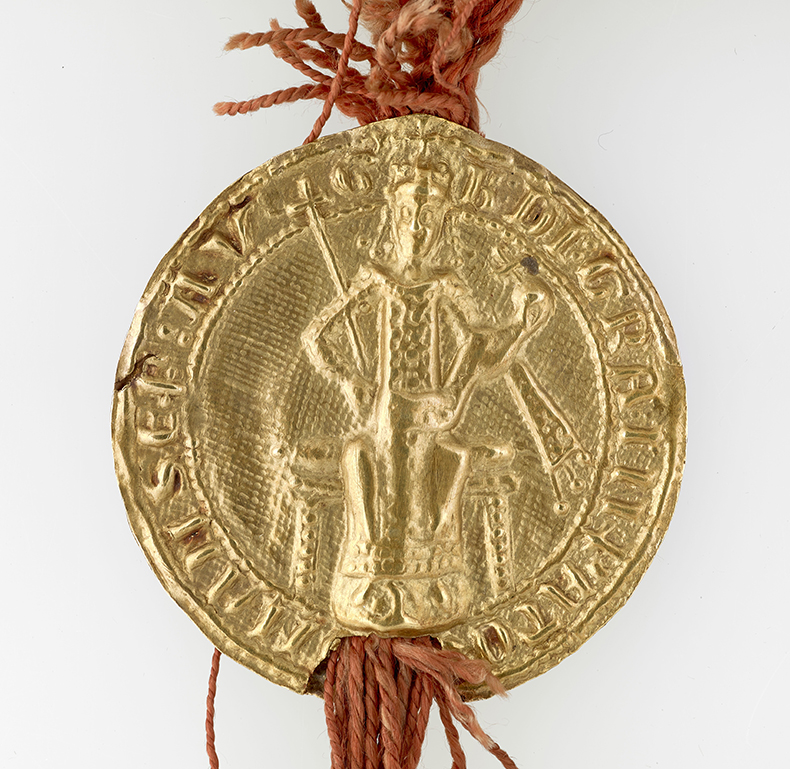
Gold seal of Emperor Baldwin II (1269), Netherlands. British Library, London. Photo: © British Library Board, London
The ways gold has been used to express or shore up political power is a clear theme of the show. In some cases, gold appears to have been a stand-in for actual power. In 1269, the ‘Emperor’ Baldwin II issued a charter authorised with a gold seal (rather than the usual wax). Some eight years earlier he had been forced to flee his ‘empire’ – by then only the city of Constantinople – after a coup; such was his haste that he left his crown and sceptre behind. From his Italian exile, Baldwin trusted that the gold seal would convey his imperial might. He died four years later, still in exile.
The gold of Baldwin’s seal is an ironic symbol of his lost power, but other artefacts testify to a flourishing of cultural life, like the Benedictional of Æthelwold. This manuscript was made during the ‘Benedictine Reform’ – a flowering of cultural activity in late 10th-century England associated with monastic reorganisation. The book was made at the behest of Æthelwold, Bishop of Winchester who – according to a preface – ordered it to be decorated with ‘many arches well adorned, filled with various figures and decorated with manifold beautiful colours’. The manuscript contains 28 figures; the page containing Saint Æthelthryth, abbess of Ely, is open in the exhibition. She is realised in soft pink, gold, blue and emerald green, shimmering beneath an intricate architectural frame constructed from rippling, knotting, intertwining acanthus patterns. The work was created so that Æthelwold might ‘sanctify the people of the Saviour by means of it… that he may lose no little lambkin of the fold’. Shepherding has never looked so beautiful.
Æthelwold’s Benedictional is a testament to his energy as a patron of the arts. We get a similar sense of the extraordinary energy of a single figure looking at a firman, or decree, issued by the Mughal emperor Shah Alam II in 1789 to Sophia Elizabeth Plowden. Plowden went to India with her husband, an East India Company officer. They lived in Calcutta and at the Lucknow court where, in between having several children (she was the mother of 10), she collected Persian and Hindustani songs, which she recorded in European notation and published to great acclaim. The decree, which bestows the honorific title of Bilqis uz-Zaman – ‘Sheba of the Age’ – on Plowden, is over a metre tall and almost completely covered in gold ink, set into a piece of red silk brocade.
Of course, gold is a precious natural resource, and its use and exploitation has come at great human cost. An illustrated kinzan emaki scroll made by artists employed by the Japanese Shogunate in the early 19th century is a reminder of this dark history. It depicts gold mining in Sado, an island off the north-west coast of Honshu. The miners are shown working in pairs, in back-breaking positions, shovelling, panning, carrying and smelting. They wear little clothing, suggesting the cloying heat deep beneath the earth.
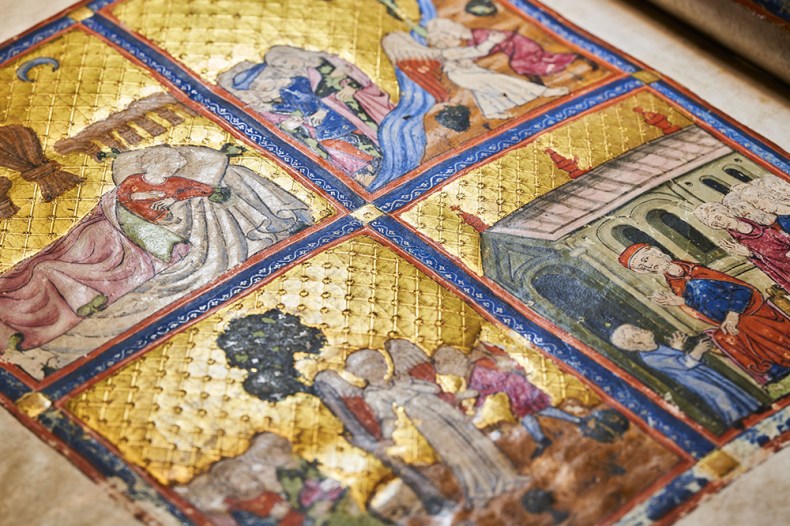
Detail from the Golden Haggadah (c. 1320), northern Spain. British Library, London. Photo: © British Library Board, London
‘Gold’ is not a large exhibition, but it takes some time go round, since every item in it demands close attention. Some are large pieces, which make you take a step back before you go in for a closer look, like a 19th-century manuscript from Myanmar depicting the hundreds of lives of the Bodhisattva (the Buddha-to-be) as he was reincarnated before enlightenment. In the folios on display we see an episode in which the Bodhisattva is an elephant – here painted in gold – who gets into a fight with a giant crab. The elephant is saved by its loyal mate (a beautiful pink and charcoal grey beast), who distracts the crab with flattering words.
Other artefacts are tiny and gorgeous, inviting you to get up close to the glass of the display cases and squint at them, like a small octagonal Qur’an from 16th-century Iran, bound in engraved gold covers and stored in a white jade case. It appears alongside a tiny copy of the Psalms (3cm by 4cm), also in a gold metalwork binding and also dating to the 16th century. It is a ‘girdle book’ – that is, made to be hung from a belt – and was likely owned by Anne Boleyn.
The show has been put together entirely from the British Library’s own collections, without any loans. This was a decision no doubt taken during the uncertainties of the Covid lockdown, but the result is a triumph showing off the gilded diversity of the library’s collection.
‘Gold’ is at the British Library, London, until 2 October.
From the July/August 2022 issue of Apollo. Preview and subscribe here.
Unlimited access from just $16 every 3 months
Subscribe to get unlimited and exclusive access to the top art stories, interviews and exhibition reviews.

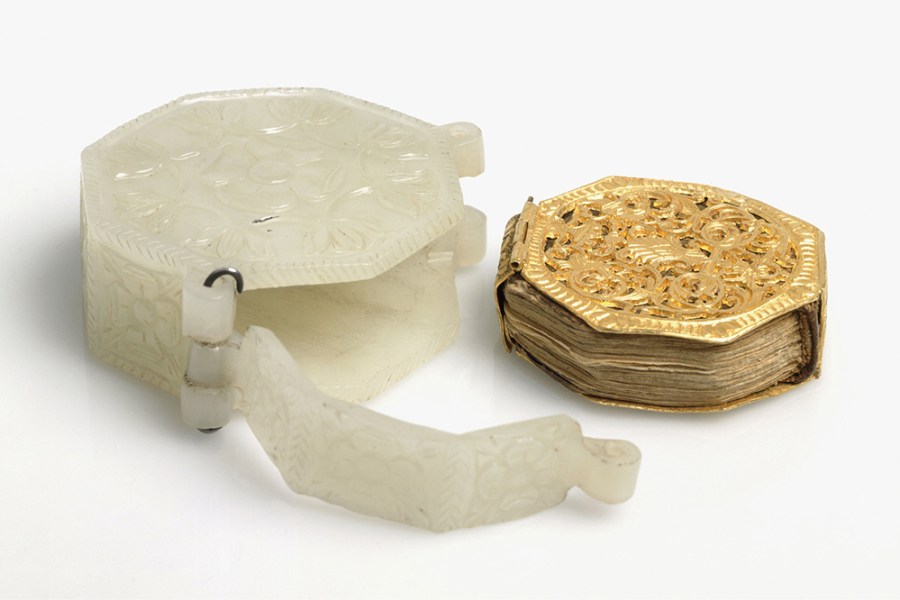
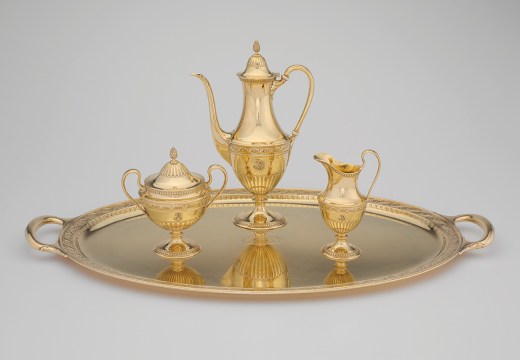
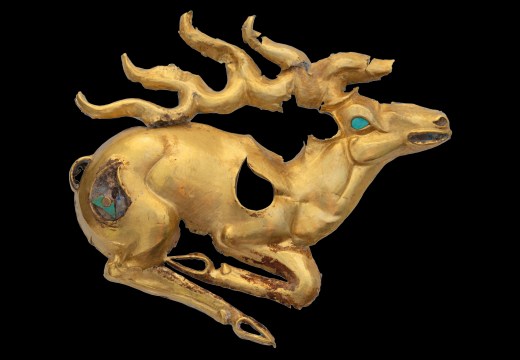
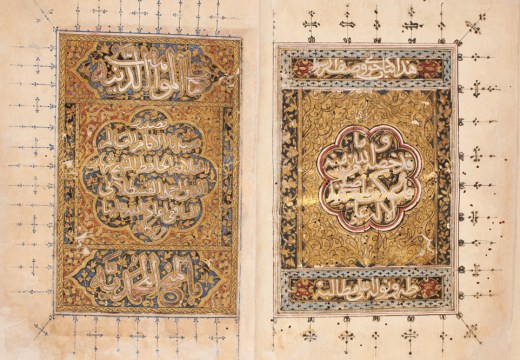









![Masterpiece [Re]discovery 2022. Photo: Ben Fisher Photography, courtesy of Masterpiece London](http://www.apollo-magazine.com/wp-content/uploads/2022/07/MPL2022_4263.jpg)
It’s time for the government of London to return to its rightful home